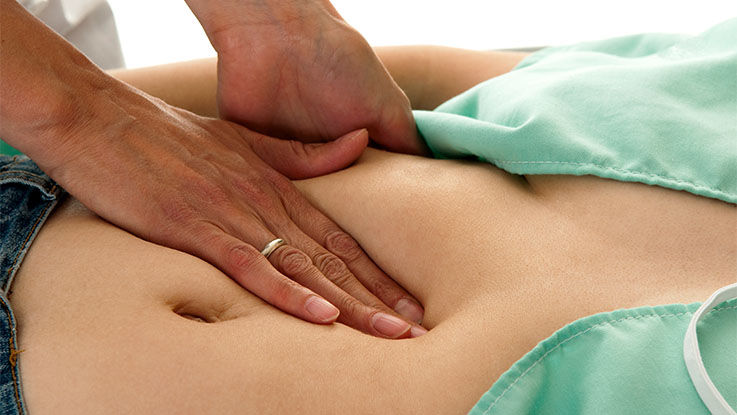Hernia surgery
Advanced hernia repair for abdominal wall and groin hernias
A hernia is a weakness or hole in the muscle of the abdominal wall, through which organs or structures from inside of your body can push through, creating a bulge. Hernias can develop in different parts of the body but they’re most common in the abdomen (belly) and groin area.
If you have a hernia (or if you think you might), we can help. At HealthPartners, you’ll find hernia care that’s comprehensive, convenient and compassionate. Our patient-centered approach ensures you get personalized care and treatment from initial consultation through recovery.
Our team includes hernia surgeons with specialized training to treat the most complex hernias, using advanced techniques in minimally invasive, robot-assisted and open hernia repair procedures. Plus, our surgeons are regularly honored as

Signs you may need treatment for your hernia
If you have a hernia, you’ll typically see a bulge through the skin on your abdomen or groin. The hernia may only be visible during certain activities like lifting, bending, coughing, sneezing, laughing or exercising. Hernias don’t always cause pain or discomfort, but when it bulges out it can feel like a tug, ache or sharp pain.
Hernias don’t always need to be treated, but it’s always a good idea to let your primary care doctor or a hernia surgeon know if you think you have one. There are also times when hernia symptoms are signs of an emergency situation.
When to seek emergency care
Hernias can sometimes cause serious problems. Head to the
- Severe pain near the hernia
- Can’t pass gas or have a bowel movement
- You experience nausea or vomiting
- There’s redness or a rash surrounding the area
Types of hernias we treat
- Diaphragmatic hernia
- Epigastric hernia
- Femoral hernia
- Hiatal hernia
- Incisional hernia
- Inguinal hernia
- Obturator hernia
- Parastomal hernia
- Spigelian hernia
- Sports hernia
- Umbilical hernia

Hernia repair surgery is the most common treatment for hernias
Hernias won’t go away without surgery. However, surgery isn’t always the best option. In some cases, your doctor may recommend treating or managing hernia symptoms with supportive garments like an abdominal binder or a truss.
Abdominal hernia surgery for different types of hernias
An abdominal hernia is a hole in your abdominal muscles. To repair an abdominal hernia, your surgeon makes one or more incisions and pushes the bulging tissue back into your abdomen. The hernia repair procedure may include stitching the hernia closed or reinforcing the area with a mesh material.
Abdominal wall hernia surgery
Abdominal wall hernias occur in different locations on your belly – they’re also called ventral hernias. The following are types of abdominal wall hernia surgeries.
Groin hernia surgery
Groin hernias usually occur in the area between the lower abdomen and thigh. The following are types of groin hernia surgeries.

Sports hernia surgery
Sports hernias can develop in athletes of all ages who play sports that involve forceful and repeated twisting of the pelvis. These motions can cause a tear in the soft tissue of the lower abdomen or groin. Sports hernias are more likely in sports such as soccer, football, ice hockey, skiing and wrestling. Treatment for sports hernias typically starts with nonsurgical options. If symptoms don’t improve in 6 to 8 weeks, surgery may be recommended.
Incisional hernia surgery
An incisional hernia forms near a previous surgical incision. About one-third of patients who have abdominal or pelvic surgery will get an incisional hernia after the procedure.
Incisional hernias can develop any time after a surgery. They’re more likely if you had a wound infection or if there’s a lot of pressure on the incision. Pressure on the incision can be caused by excessive exercise, obesity or becoming pregnant. Recommended treatment depends on the hernia location, size and symptoms.
Your options for diaphragmatic hernia surgery
Hernias can also develop on the diaphragm, the dome-shape muscular barrier between the chest and abdominal cavities. To repair a diaphragmatic hernia, the surgeon makes one or more incisions and pushes the herniated tissues back into place, then uses strong stitches or mesh to reinforce the area.
Hiatal hernia surgery
A hiatal hernia is when the upper part of your stomach pushes through the opening where your esophagus passes through to connect to your stomach (this is called the esophageal hiatus). The esophageal hiatus can get bigger over time, which is why hiatal hernias are more common as you get older.
You can’t see a hiatal hernia and they don’t always cause symptoms. They’re usually found during a test to see what’s causing heartburn or pain in the chest or upper abdomen. Symptoms of hiatal hernias can often be managed with medicines. However, if medication doesn’t work, surgery may be an option.
Diaphragmatic hernia surgery
A diaphragmatic hernia occurs when one or more of your abdominal organs move upward into your chest through an opening in the diaphragm. Diaphragmatic hernias are usually present at birth, but adults and children may develop one following severe trauma. Surgery is typically recommended for these types of hernias.

What to expect at a hernia surgery consultation
What happens at your consultation will depend on the type, size and location of the hernia. In most cases, you’ll receive a physical exam and answer questions about your health history. You may also need imaging tests to confirm a diagnosis.
We’ll personalize your hernia treatment plan based on the information we gather about the hernia and your health.
How characteristics of the hernia influence your treatment plan
If a hernia isn’t causing bothersome symptoms, it may not make sense to repair it right away – we may recommend a “wait and see” approach. We’ll also consider the hernia size, type, location and previous treatments to identify if there are reasons why the hernia would be difficult to repair or more likely to come back.
How your personal health factors influence your treatment plan
We’ll also consider your age, overall health and previous surgeries. Some health factors can make hernia surgery less safe, slow
When hernia surgery is recommended
If hernia surgery is the best option for you, we’ll discuss what you can expect from the procedure and possible surgical techniques we’ll use.
We’ve adopted the latest diagnostic and surgical technologies, ensuring precise treatments with shorter recovery times. Our surgeons are always innovating and improving the results of hernia surgery, and often participate in research studies. Your doctor may ask if you’re interested in
One or more of the following surgeries may be an option for you:
Open (traditional) hernia repair surgery
Open surgery uses a single cut that allows surgeons to operate directly on herniated tissue. Open surgery may be recommended for large or complicated hernias, or if you have a hernia that keeps coming back.
Laparoscopic hernia repair surgery
During a laparoscopic procedure, a surgeon will operate through small incisions around the hernia. This surgery uses a laparoscope, which is a thin tube that includes a tiny video camera. The surgeon inserts surgical instruments into the incisions and uses the images captured by the video camera to guide the repair. Laparoscopic surgery is generally used for small to medium hernias.
Robot-assisted hernia repair surgery
Robotic hernia surgery is similar to laparoscopic surgery and is done through small incisions. The difference is that a surgical robot is used to complete the repair. During a robotic hernia repair, the surgeon uses a screen to direct a robotic arm to perform precision movements. Robotic surgery may be used to repair many types of hernias of various sizes and complexity.
What happens if hernia surgery isn’t an option at this time
If surgery isn’t an option or if it will take a long time to prepare for hernia surgery, your care team will recommend ways to control your symptoms, including medications, lifestyle changes or medical devices. If hernia surgery may be an option in the future, we’ll connect you with the support and treatments you need to prepare for the procedure.

How we’ll help you get ready for hernia surgery
If you’re not yet ready for hernia surgery, we can help get you there – and you’ll have the support of the entire HealthPartners care system, which includes 100s of doctors in dozens of specialties. Depending on your situation, your support team may include:
- Primary care doctor – Your
primary care doctor can help with managing medical conditions, nutrition concerns, smoking cessation and more. We recommend no smoking for at least four weeks before and after surgery. - Nutritionist or dietitian – A
nutritionist can suggest diet changes if you need help with malnutrition or weight control. - Weight loss specialists – The experts at the
Bariatric Surgery and Weight Center can help people get to a healthy weight before hernia surgery. Losing weight before surgery helps reduce the risk of a hernia coming back after surgery. - Endocrinologist – When there are concerns that your blood sugar may impact healing, we may refer you to an endocrinologist for
diabetes care and support. Ideally your hemoglobin A1c should be less than 7.5. - Physical therapy – If your body is not strong enough for surgery, we may recommend
physical therapy oroccupational therapy . - Infectious diseases – If you have a current infection that could interfere with wound healing, we may refer you for
infectious disease treatment .
What to expect after hernia surgery
Sometimes people are able to go home on the day of their hernia repair. But if the repair was complex, you may have to stay in the hospital after surgery. In either case, you’ll need someone to drive you home.
Once you’re home, you’ll need to rest for the first few days. You’ll receive instructions about how to take care of surgical incisions and information about diet and activity restrictions. It is also important to go to any follow-up appointments.
How long it takes to recover from a hernia surgery
Recovery time from hernia surgery depends on the type of hernia and surgery you had. Recovery time after laparoscopic surgery may be 1-2 weeks, but with open hernia surgery it could take 4-8 weeks.
The time you’ll be out of work is largely affected by the type of hernia repair and the type of job you have. If your job isn’t physically demanding, you should be able to return to work within a few days. But if you need to lift things as part of your job, you’ll need to be out longer.
